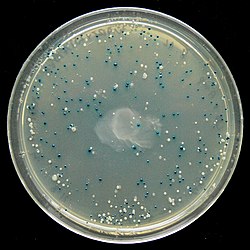Blue–white screen

The blue–white screen is a
Background
The method is based on the principle of α-complementation of the
The pUC series of plasmid
Molecular mechanism

In this method of screening, the host E. coli strain carries the lacZ deletion mutant (lacZΔM15) which contains the ω-peptide, while the plasmids used carry the lacZα sequence which encodes the first 59 residues of β-galactosidase, the α-peptide. Neither is functional by itself. However, when the two peptides are expressed together, as when a plasmid containing the lacZα sequence is transformed into a lacZΔM15 cells, they form a functional
The blue–white screening method works by disrupting this α-complementation process. The plasmid carries within the lacZα sequence an internal
The presence of an active β-galactosidase can be detected by X-gal, a colourless analog of lactose that may be cleaved by β-galactosidase to form 5-bromo-4-chloro-indoxyl, which then spontaneously dimerizes and oxidizes to form a bright blue insoluble pigment 5,5'-dibromo-4,4'-dichloro-indigo. This results in a characteristic blue colour in cells containing a functional β-galactosidase. Blue colonies therefore show that they may contain a vector with an uninterrupted lacZα (therefore no insert), while white colonies, where X-gal is not hydrolyzed, indicate the presence of an insert in lacZα which disrupts the formation of an active β-galactosidase.
The recombinant clones can be further analyzed by isolating and purifying small amounts of plasmid DNA from the transformed colonies and restriction enzymes can be used to cut the clone and determine if it has the fragment of interest.[6] If the DNA is necessary to be sequenced, the plasmids from the colonies will need to be isolated at a point, whether to cut using restriction enzymes or performing other assays.
Practical considerations
The correct type of
X-gal is light-sensitive and therefore its solution and plates containing X-gal should be stored in the dark. Isopropyl β-D-1-thiogalactopyranoside (IPTG), which functions as the inducer of the lac operon, may be used in the media to enhance the expression of LacZ.
X-gal is an expensive material, thus other methods have been developed in order to screen bacteria. GFP has been developed as an alternative to help screen bacteria. The concept is similar to α-complementation in which a DNA insert can disrupt the coding sequence within a vector and thus disrupt the GFP production resulting in non-fluorescing bacteria.[7] Bacteria that have recombinant vectors (vector + insert), will be white and not express the GFP protein, while non-recombinant (vector), will and fluoresce under UV light. GFP in general has been used as a reporter gene where individuals can definitively determine if a clone carries a gene that researchers are analyzing. On occasion, the medium in which the colonies grow can influence the screen and introduce false-positive results.[8] X-gal on the medium can occasionally degrade to produce a blue color or GFP can lose its fluorescence because of the medium and can impact researchers capabilities to determine colonies with the desire recombinant and those that do not possess it.[9]
Drawbacks
Some white colonies may not contain the desired recombinant plasmid for a number of reasons. The ligated DNA may not be the correct one or not properly ligated, and it is possible for some linearized vector to be transformed, its ends "repaired" and ligated together such that no LacZα is produced and no blue colonies may be formed. Mutation can also lead to the α-fragment not being expressed. A colony with no vector at all will also appear white, and may sometimes appear as satellite colonies after the antibiotic used has been depleted. It is also possible that blue colonies may contain the insert. This occurs when the insert is "in frame" with the LacZα gene and a STOP codon is absent in the insert. This can lead to the expression of a fusion protein that has a functional LacZα if its structure is not disrupted. The correct recombinant construct can sometimes give lighter blue colonies which may complicate its identification.
See also
- Complementation test
- pBLU
- pGreen
- pUC19
- Recombinant DNA
